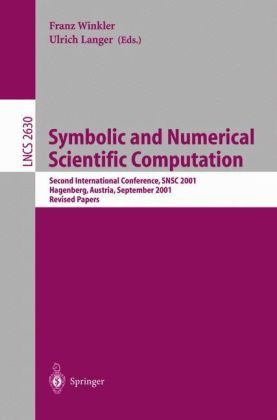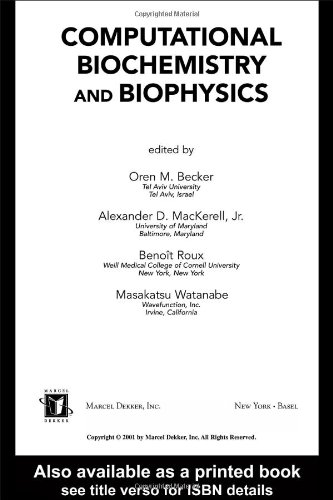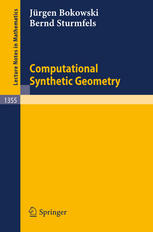S. S. Quek, G.R. Liu9780750658669, 9781417505593, 0750658665
Table of contents :
CONTENTS……Page 6
BIOGRAPHICAL INFORMATION……Page 10
Preface……Page 12
1.1 INTRODUCTION……Page 18
1.2 PHYSICAL PROBLEMS IN ENGINEERING……Page 20
1.3.1 Modelling of the Geometry……Page 21
1.3.2 Meshing……Page 22
1.3.4 Boundary, Initial and Loading Conditions……Page 23
1.4.1 Discrete System Equations……Page 24
1.4.2 Equation Solvers……Page 25
1.5 VISUALIZATION……Page 26
2.1 INTRODUCTION……Page 29
2.2.1 Stress and Strain……Page 30
2.2.2 Constitutive Equations……Page 33
2.2.3 Dynamic Equilibrium Equation……Page 34
2.2.4 Boundary Conditions……Page 35
2.3.1 Stress and Strain……Page 36
2.3.2 Constitutive Equations……Page 38
2.4 EQUATIONS FOR TRUSS MEMBERS……Page 39
2.4.1 Stress and Strain……Page 40
2.5.1 Stress and Strain……Page 41
2.5.3 Moments and Shear Forces……Page 43
2.6.1 Stress and Strain……Page 45
2.6.3 Moments and Shear Forces……Page 47
2.6.5 Reissner–Mindlin Plate (Reissner, 1945; Mindlin, 1951)……Page 49
2.7 REMARKS……Page 51
3.1 INTRODUCTION……Page 52
3.2 STRONG AND WEAK FORMS……Page 53
3.3 HAMILTON’S PRINCIPLE……Page 54
3.4.1 Domain Discretization……Page 55
3.4.2 Displacement Interpolation……Page 56
3.4.3 Standard Procedure for Constructing Shape Functions……Page 58
3.4.4 Properties of the Shape Functions1……Page 61
3.4.5 Formation of FE Equations in Local Coordinate System……Page 69
3.4.6 Coordinate transformation……Page 72
3.4.9 Solving the Global FE Equation……Page 74
3.6 ANALYSIS OF FREE VIBRATION (EIGENVALUE ANALYSIS)……Page 75
3.7.1 Central Difference Algorithm……Page 77
3.7.2 Newmark’s Method (Newmark, 1959)……Page 80
3.8.3 Recap of FEM Procedure……Page 81
3.9 REVIEW QUESTIONS……Page 82
4.2.1 Shape Function Construction……Page 84
4.2.2 Strain Matrix……Page 87
4.2.4 Element Matrices in the Global Coordinate System……Page 88
4.2.6 Recovering Stress and Strain……Page 92
Example 4.1: A uniform bar subjected to an axial force……Page 93
4.3.1 Properties of the FEM……Page 95
Example 4.2: A triangular truss structure subjected to a vertical force……Page 96
4.4 HIGH ORDER ONE-DIMENSIONAL ELEMENTS……Page 104
4.5 REVIEW QUESTIONS……Page 105
5.2.1 Shape Function Construction……Page 107
5.2.3 Element Matrices……Page 110
Example 5.1: A uniform cantilever beam subjected to a downward force……Page 112
5.5 CASE STUDY: RESONANT FREQUENCIES OF MICRO RESONANT TRANSDUCER……Page 115
5.5.2 ABAQUS Input File……Page 117
5.5.3 Solution Process……Page 120
5.5.4 Result and Discussion……Page 121
5.6 REVIEW QUESTIONS……Page 124
6.1 INTRODUCTION……Page 125
6.2.1 Equations in Local Coordinate System……Page 126
6.2.2 Equations in Global Coordinate System……Page 129
6.3.1 Equations in Local Coordinate System……Page 131
6.3.2 Equations in Global Coordinate System……Page 133
6.4 REMARKS……Page 137
6.5 CASE STUDY: FINITE ELEMENT ANALYSIS OF A BICYCLE FRAME……Page 138
6.5.2 Abaqus Input File……Page 139
6.5.3 Solution Processes……Page 142
6.5.4 Results and Discussion……Page 143
6.6 REVIEW QUESTIONS……Page 144
7.1 INTRODUCTION……Page 146
7.2 LINEAR TRIANGULAR ELEMENTS……Page 148
7.2.1 Field Variable Interpolation……Page 149
7.2.2 Shape Function Construction……Page 150
7.2.3 Area Coordinates……Page 154
7.2.4 Strain Matrix……Page 156
7.2.5 Element Matrices……Page 157
7.3 LINEAR RECTANGULAR ELEMENTS……Page 158
7.3.1 Shape Function Construction……Page 159
7.3.2 Strain Matrix……Page 161
7.3.4 Gauss Integration……Page 162
7.4.1 Coordinate Mapping……Page 165
7.4.2 Strain Matrix……Page 168
7.4.4 Remarks……Page 169
7.5.1 Triangular Element Family……Page 170
7.5.2 Rectangular Elements……Page 173
7.6 ELEMENTS WITH CURVED EDGES……Page 177
7.7 COMMENTS ON GAUSS INTEGRATION……Page 178
7.8 CASE STUDY: SIDE DRIVE MICRO-MOTOR……Page 179
7.8.1 Modelling……Page 180
7.8.2 ABAQUS Input File……Page 182
7.8.3 Solution Process……Page 184
7.8.4 Results and Discussion……Page 185
7.9 REVIEW QUESTIONS (PETYT, 1990)……Page 188
8.2 PLATE ELEMENTS……Page 190
8.2.1 Shape Functions……Page 194
8.2.2 Element Matrices……Page 195
8.3 SHELL ELEMENTS……Page 197
8.3.1 Elements in Local Coordinate Systems……Page 198
8.4 REMARKS……Page 201
8.5.1 Modelling……Page 202
8.5.2 ABAQUS Input File……Page 203
8.5.4 Result and Discussion……Page 205
8.6.1 Modelling……Page 209
8.6.2 ABAQUS Input File……Page 210
8.6.4 Result and Discussion……Page 213
8.7 REVIEW QUESTIONS……Page 215
9.1 INTRODUCTION……Page 216
9.2.1 Strain Matrix……Page 217
9.2.2 Element Matrices……Page 221
9.3.1 Strain Matrix……Page 226
9.3.2 Element Matrices……Page 230
9.4.1 Tetrahedron Elements……Page 233
9.4.2 Brick Elements……Page 235
9.5 ELEMENTS WITH CURVED SURFACES……Page 239
9.6 CASE STUDY: STRESS AND STRAIN ANALYSIS OF A QUANTUM DOT HETEROSTRUCTURE……Page 240
9.6.1 Modelling……Page 241
9.6.2 ABAQUS Input File……Page 244
9.6.3 Solution Process……Page 247
9.7 REVIEW QUESTIONS……Page 249
10.1 INTRODUCTION……Page 250
10.2 CRACK TIP ELEMENTS……Page 251
10.3 METHODS FOR INFINITE DOMAINS……Page 253
10.3.1 Infinite Element Formulated by Mapping (Bettess, 1992)……Page 254
10.3.2 Gradual Damping Elements……Page 257
10.4 FINITE STRIP ELEMENTS……Page 259
10.5 STRIP ELEMENT METHOD (SEM)……Page 262
11.1 INTRODUCTION……Page 263
11.2 CPU TIME ESTIMATION……Page 264
11.3 GEOMETRY MODELLING……Page 265
11.4.2 Element Distortion……Page 267
11.5.1 Different Order of Elements……Page 271
11.5.2 Straddling Elements……Page 272
11.6.1 Mirror Symmetry or Plane Symmetry……Page 273
11.6.2 Axial Symmetry……Page 279
11.6.4 Repetitive Symmetry……Page 281
11.7.1 Methods for Modelling Offsets……Page 282
11.7.2 Creation of MPC Equations for Offsets……Page 284
11.8 MODELLING OF SUPPORTS……Page 287
11.9 MODELLING OF JOINTS……Page 288
11.10.2 Enforcement of Mesh Compatibility……Page 291
11.10.3 Modelling of Constraints by Rigid Body Attachment……Page 294
11.11 IMPLEMENTATION OF MPC EQUATIONS……Page 295
11.11.2 Penalty Method……Page 296
11.12 REVIEW QUESTIONS……Page 297
12.1.1 Heat Transfer in a Two-Dimensional Fin……Page 299
12.1.2 Heat Transfer in a Long Two-Dimensional Body……Page 300
12.1.3 Heat Transfer in a One-Dimensional Fin……Page 301
12.1.4 Heat Transfer Across a CompositeWall……Page 302
12.1.5 Torsional Deformation of a Bar……Page 303
12.1.7 Acoustic Problems……Page 304
12.2 WEIGHTED RESIDUAL APPROACH FOR FEM……Page 305
12.3.1 One-Dimensional Fin……Page 306
12.3.2 Direct Assembly Procedure……Page 311
12.3.3 Worked Example……Page 312
12.3.4 Remarks……Page 314
12.3.5 CompositeWall……Page 315
12.3.6 Worked Example……Page 316
12.4.1 Element Equations……Page 320
12.4.2 Triangular Elements……Page 322
12.4.3 Rectangular Elements……Page 324
12.4.4 Boundary Conditions and Vector b(……Page 325
12.4.5 Point Heat Source or Sink……Page 331
12.5 SUMMARY……Page 333
12.6.2 ABAQUS Input File……Page 335
12.6.3 Result and Discussion……Page 337
12.7 REVIEW QUESTIONS……Page 338
13.1 INTRODUCTION……Page 341
13.2 BASIC BUILDING BLOCK: KEYWORDS AND DATA LINES……Page 342
13.3 USING SETS……Page 343
13.4 ABAQUS INPUT SYNTAX RULES……Page 344
13.4.2 Data Lines……Page 345
13.5 DEFINING A FINITE ELEMENT MODEL IN ABAQUS……Page 346
13.5.1 Model Data……Page 347
13.5.2 History Data……Page 348
13.5.3 Example of Cantilever Beam Problem……Page 349
13.6 GENERAL PROCEDURES……Page 356
REFERENCES……Page 359
INDEX……Page 362







Reviews
There are no reviews yet.